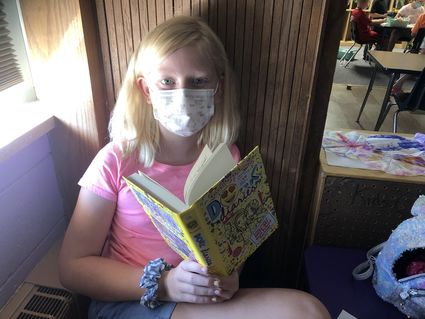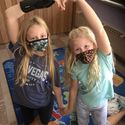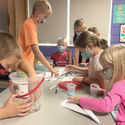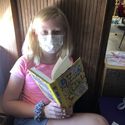School days in a pandemic: ready, set, mask
September 4, 2020
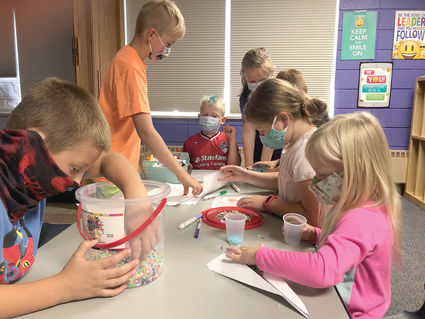
Jana Peterson
Children at Cloquet's Kids Corner engage in various arts and craft activities after lunch, with masks on and no problems. Pictured, from left, are Jax, 7, Kellen, 9, Gav, 7, Brenna, 9, and Bailey, 4.
When the Kids Corner child care program opted to make masks mandatory for its summer program, the initial reaction was skeptical, she said. But staff and parents have been pleasantly surprised by how readily the kids - mostly school-aged - got with the program.
"We looked at it as training," said Community Ed director Ruth Reeves, "and we figured it was their future."
That gave their kids a nearly two-month head start on the rest of the state, which joined them on July 25 after Minnesota governor Tim Walz mandated that people had to wear masks indoors in public spaces.
Reeves said childcare providers have had to continually adapt, as researchers and doctors learn more about COVID-19, the disease caused by the coronavirus pandemic that has affected countries across the globe. Early on there was a lot of focus on cleaning surfaces and hand washing/sanitizing, then masks were emphasized more as scientists realized the disease is often spread through the air through aerosolized droplets that come from people's mouths when they talk, sing or shout.
"Luckily, we had a lot of donated masks, wonderful, colorful masks with mermaids and superheroes and lots of different designs," she said.
The child care center kept it simple. Each child got to choose two masks, marked with their names. The masks stayed at Kids Corner so parents wouldn't have to remember to pack them. Each morning when the children arrived, they would grab one of their masks (kept in a baggie) and put it on. If they took it off to go outside, to the gym or to eat, the mask went into a laundry basket to be washed, and the kids would put on a fresh mask when they came back inside. They also purchased a lot of disposable masks, which the kids are free to wear.
"We looked to teach them why they should wear a mask and make it fun," said Reeves. "It's a little bit like being Halloween everyday."
After lunch on Wednesday, a group of kids ages 4-10 were playing in a classroom at Kids Corner. They were all wearing masks, and many seemed oblivious to the fabric covering their faces as they intently drew, made fuse bead designs, read or found other ways to amuse themselves.
When asked, 9-year-old twins Ava and Reese both said they think masks are "fine" - now they are used to wearing them at Kids Corner and dance, and soon they'll be wearing them at school.
Friend and fellow dancer Kenadie, 10, agreed, adding that the mask doesn't necessarily make her feel safer, it's basically "just another rule." But that's OK.
Reeves said some students struggled with wearing masks - for different reasons - and staff didn't force it. She told how they knew one little boy was not likely to put on a mask, and he didn't initially. But staff have worked with him slowly over the summer and now he's wearing a mask.
"That's one battle this fall that won't have to happen in the classroom," Reeves said. "It's routine now for a lot of the kids. It's been very successful, even more than we thought it would be when we started."
The rules and research on masks are changing too. Now more researchers are looking at what kind of face covering is most effective: cloth masks and surgical masks are pretty good, thin neck gaiters and bandanas are not as effective at trapping the droplets. Adding a filter or another layer of cloth would help in those cases.
"I'm glad we did it, as more information came out about the importance of wearing masks," Reeves said. "And knock on wood, thus far we haven't had any direct cases (where the disease was transmitted at the child care program) that I'm aware of. We've had a lot of close calls - kids who've been tested or staff who have ended up staying home for two weeks - but we haven't had any outbreaks."
With nearly all of Carlton County schools returning to in-person learning full-time or on a part-time (hybrid) basis, parents of younger students may be wondering how they can help their children transition from learning at home to going back to new rules at school.
Essentia Health developed an online back-to-school toolkit that offers a number of strategies to help keep your child safe, simple measures such as wearing masks, socially distancing, washing hands frequently and staying home when sick. Many of the tips included in the Essentia toolkit are reprinted below, with permission.
WEARING A MASK
Q: Why is it important to wear a mask?
When worn properly and consistently, face masks are one of the best tools we have to protect against COVID. This virus is spread via respiratory droplets by people of all ages, and masks restrict the travel of those droplets. Many with COVID are asymptomatic, so you could unknowingly have the virus. This means that wearing a mask protects those around you.
Q: What kind of mask should my child wear?
Homemade or cloth face coverings are sufficient for most people, according to the American Academy of Pediatrics. Pleated masks, with elastic, often are best for kids. High-risk or immunocompromised children should consult their primary care physician.
Q: What is the proper way to put on and wear a mask?
A mask should cover both your mouth and nose. It should fit snugly against the sides of your face, and be secured under your chin, but not so tight that it's uncomfortable; you should be able to breathe without issue. Please remember to wash your hands before putting on your mask and avoid touching it once it's on your face.
Q: How do I get my child used to wearing a mask during the school day?
Wearing a mask continuously can be uncomfortable for adults and can be even more daunting for children. Here are some suggestions to make it easier:
-Give them choices. Let your child select the mask they will wear just like you would a pair of shoes or a sweatshirt, to ensure a better chance of acceptance.
-Get them into practice. Have your child practice wearing their mask in the days and weeks before returning to school.
-Explain why they're being asked to wear a mask. An age-appropriate explanation of COVID will help them understand the "why" and may clear up any questions they continue to grapple with.
-Practice what you preach. Your child will be more inclined to wear a mask if they see Mom and Dad doing so without complaint.
Q: How do I properly clean my child's mask and how often?
Wearing a mask is only half the battle; equally important is to make sure that mask is clean and sanitary. The CDC recommends washing your mask after each use.
Using a washer and dryer
-Washing: Use the warmest water setting appropriate for the mask material.
-Drying: Use the highest heat setting to dry the mask.
Washing and drying by hand
-Washing: Follow the CDC's instructions for washing by hand with a bleach solution.
-Drying: Lay it flat and in direct sunlight, if possible.
SOCIAL DISTANCING
Q: What does social distancing look like?
When infected droplets are unable to pass from person to person via sneezing, coughing or talking, COVID has fewer potential targets. The CDC says limiting face-to-face contact is the best way to slow the spread. Social, or physical, distancing guidelines suggest maintaining a space of 6 feet between individuals in public settings, both inside and outside. Six feet is equal to about two arm's length.
Q: What can we do to make riding the bus safer?
Social distancing also applies on the bus. The AAP highlights several steps that schools can take to facilitate this, including minimizing the number of people on the bus and using tape to show students where to sit. Other suggestions are to enforce assigned seating, requiring masks and keeping windows open, weather permitting. Check with your school to learn about its bus policy.
Q: Should my child stay home if they have a cold or symptoms similar to those of COVID?
If your child is sick, keep them home. But because many of the symptoms consistent with COVID overlap with those of other viral illnesses such as the cold or flu (fatigue, congestion, body aches, etc.), we recommend consulting your child's primary care physician for further guidance. The doctor will help you decide if your child can recover at home, should come in to be tested, or would benefit from a video visit.
To see the entire Essentia Health toolkit and view included videos, visit essentiahealth.org/covid-19/back-to-school-covid-19-digital-toolkit.
To find out more about your school district's plan, visit their website or ask for a printed copy at school.


